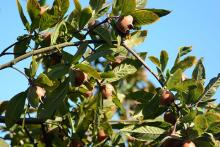Crataegus germanica
Common name:
Medlar
Pronunciation:
kra-TEE-gus ger-mah-ni-ke
Family:
Rosaceae
Genus:
Synonyms:
Mespilus germanica
Type:
Broadleaf
Native to (or naturalized in) Oregon:
No
- Broadleaf deciduous, small tree or shrub, to about 16 ft (5 m). Bark gray-brown, fissured occasionally flaking. Branches thorny, but cultivated selections may be thornless. Leaves simple, alternate, oblong lanceolate, to 12 cm long, very short petiole, margin serrate, dull green above, tomentose below, yellow and brownish red in fall. Flowers white, 5 cm wide and 5-petaled, often solitary but sometimes paired. Fruit turban-like in shape, 2.5 cm or more, with 5 calyx lobes, tan, brown when ripe. Fruit needs to be stored in cold for it to soften. (Called bletting, a process of softening that certain fleshy fruit undergo, beyond ripening. Some fruit can be eaten raw only after bletting, such as medlar, persimmon, and quince.)
- Hardy to USDA Zone (4)5 Native to southeastern Europe and southwestern Asia, especially the Black Sea coasts of Bulgaria and of modern Turkey
- Full sun, cultivate as an apple
- germanic: of Germany, (although not part of its native range)






